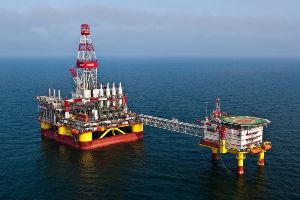The Yu. Korchagin field was discovered by LUKOIL in 2000. Its 3Р category hydrocarbon reserves exceed 270 million BOE. The maximum expected output is 2.5 million tons of oil and 1 billion cubic meters of gas annually. Between 2004 and 2009, LUKOIL invested a total of RUR 34.4 billion into field development. The Company expects to extract 343 thousand tons of oil till the end of the year.
The field's infrastructure includes the following facilities:
- An ice-resistant stationary platform (IRP-1) equipped with a drilling complex that has a loading capacity of 560 tons to drill wells 7,400 meters deep. The number of wells is 30. IRP-1 was constructed at the Astrakhansky Korabel plant.
- An additional ice-resistant stationary platform (IRP-2) for personnel accommodation. The living quarters can accommodate 105 people. Operation in the autonomous mode can reach 15 days. IRP-2 was constructed at ООО LUKOIL-Kaliningradmorneft’s plant.
- A subsea pipeline with a length of 58 kilometers, diameter of 300 millimeters, and a wall thickness of 16 millimeters.
- A floating storage unit. The deadweight is 28,000 tons. It carries a crew of 25 men. The floating storage unit is mounted outside of the Caspian ice zone.
Oil will be transported from the area by shuttle tankers with deadweight of six to twelve thousand tons.
At the moment the third well is being drilled for water injection in order to maintain the formation pressure. The first well was drilled for oil extraction and the second one for extraction of associated gas that will be used for autonomous power supply to the facility.
The Company implemented a unique for Russia engineering and technological solution, which is drilling horizontal wells with a length exceeding 5 kilometers. Due to a regular radial location of the wells, it is possible to simultaneously drill in all productive formations. Monitoring of the drilling process is also conducted from the shore via satellite channel in the on-line mode.
During an oilfield construction LUKOIL conducted satellite monitoring of the northern part of the Caspian Sea. The satellite data were received by the Company’s specialists in the quasi-real mode via the webservice LUKOIL-Kosmosnimki. The monitoring revealed no evidence of oil spills within the boundaries of the Company’s license areas during the whole monitoring period.
14 Декабря 2025 | воскресенье | 04:32


